Customers looking for affordable SIM only deals with plenty of tariff options will find O2 has a wider selection, including 30-day deals.
Yet EE have faster 4G speeds, wider geographical coverage, and a stronger customer service record too.
If the choice is on price alone, O2 may be the winner, but the EE network offers more to customers.

At a glance
| O2 | EE | |
|---|---|---|
| Prices from | £10 | £13 |
| Contract length | 30 days to 36 months | 12 months to 24 months |
| 4G speeds | 17.3Mbps average | 39.0Mbps average |
| 4G geographical coverage | 80% | 85% |
| 4G indoor coverage | 95% | 93% |
| Customer satisfaction | 91% | 92% |
SIM only plans
Winner: O2 offer a wider range of SIM only deals at cheaper prices.
On SIM only deals, both O2 and EE offer 24-month contracts and 12-month deals, although EE have largely stopped offering mid-range data deals, so it's little or lots as far as data is concerned.
These are some 24-month SIM only tariffs from the two mobile providers:
| Package | Minutes | Data | Contract term | Monthly price | ||
|---|---|---|---|---|---|---|
| O2 | 12GB data (4G) | Unlimited | 12GB | 24 months | £12 | Get deal |
| EE | 160GB 5G data | Unlimited | 160GB | 24 months | £20 | Get deal |
| O2 | Unlimited data | Unlimited | Unlimited | 24 months | £25 | Get deal |
| EE | Unlimited 5G data | Unlimited | Unlimited | 24 months | £37 | Get deal |
On the face of it, O2 is cheaper, and it should be noted that all O2's deals can be taken with a 5G SIM, so it isn't a case of getting 5G plans with EE and not O2.
Yet EE do include a choice of one Smart Benefit (swappable throughout the contract) compared to the maximum 12 months of an O2 Extra.
We've got a full guide to unlimited data SIM only plans for more in-depth reading.
When it comes to 12-month deals, EE only offer limited data plans while O2's range is much wider. These are all EE's current deals alongside some of O2's:
| Package | Minutes | Data | Contract term | Monthly price | ||
|---|---|---|---|---|---|---|
| O2 | 1GB data | Unlimited | 1GB | 12 months | £12 | Get deal |
| EE | 250MB data (4G) | Unlimited | 250MB | 12 months | £13 | Get deal |
| O2 | 4GB data | Unlimited | 4GB | 12 months | £14 | Get deal |
| EE | 1GB data (4G) | Unlimited | 1GB | 12 months | £16 | Get deal |
| EE | 3GB data (4G) | Unlimited | 3GB | 12 months | £19 | Get deal |
| O2 | Unlimited data | Unlimited | Unlimited | 12 months | £33 | Get deal |
It's clear EE aren't really interested in pushing 12-month plans to customers, with O2 offering vastly superior data packages.
Note, also, that EE's plans are 4G only, while O2 customers can again opt for 5G if they have a 5G-capable handset.
Read more about the cheapest SIM only options or compare SIM only tariffs from all mobile providers.
30-day SIM only deals
O2 also give customers the option to take SIM only plans on rolling 1-month deals, something EE doesn't offer.
Here are the two extremes of O2's 1-month deals:
| Package | Minutes | Data | Contract term | Monthly price | ||
|---|---|---|---|---|---|---|
| O2 | 1GB data | 1000 minutes Unlimited texts | 1GB | 1 month | £15 | Get deal |
| O2 | Unlimited data | Unlimited | Unlimited | 1 month | £36 | Get deal |
The prices are obviously higher than longer deals, but the flexibility may suit some customers, and this is something available with O2 but not EE.
Pay as you go
Neither O2 nor EE offer traditional pay as you go plans anymore, but they do allow customers to pay for fixed amounts of data, minutes and texts every month.
O2 call these Big Bundles. For EE, they're Jam-packed PAYG data packs. These are the cheapest and most expensive on each network:
| Package | Minutes | Data | Contract term | Monthly price | ||
|---|---|---|---|---|---|---|
| O2 | 6GB data Big Bundle | Unlimited | 6GB | PAYG | £10 | Get deal |
| EE | £10 Jam-packed PAYG | 100 minutes Unlimited texts | 4GB | PAYG | £10 | Get deal |
| O2 | 100GB data Big Bundle | Unlimited | 100GB | PAYG | £30 | Get deal |
| EE | £30 Jam-packed PAYG | Unlimited | 60GB | PAYG | £30 | Get deal |
The pricing may be the same, but O2 offer more to their PAYG customers than EE do, although EE offers data rollover while O2 doesn't.
Device plans
Winner: EE is often slightly cheaper, although specific phone plans will vary.
O2 and EE offer a vast range of handsets on pay monthly deals, with everything from basic 4G devices up to the latest flagship phones from Samsung and Apple available.
We'd highly recommend using our search function to compare mobile handset deals by narrowing down manufacturer, model and data requirements, but here are two examples of device plans offered by O2 and EE.
Here's the Samsung Galaxy A52 5G:
| Handset | Minutes | Data | Initial price | Monthly price | ||
|---|---|---|---|---|---|---|
| EE | Samsung Galaxy A52 5G | Unlimited | 4GB | £50 | £31 24 month term | Get deal |
| O2 | Samsung Galaxy A52 5G | Unlimited | 5GB | £10 | £33.48 24 month term |
Get deal |
| EE | Samsung Galaxy A52 5G | Unlimited | Unlimited | Free | £44 24 month term |
Get deal |
| O2 | Samsung Galaxy A52 5G | Unlimited | Unlimited | £10 | £46.48 24 month term |
Get deal |
And this is the OPPO Find X3 Neo:
| Handset | Minutes | Data | Initial price | Monthly price | ||
|---|---|---|---|---|---|---|
| EE | OPPO Find X3 Neo | Unlimited | 4GB | £100 | £33 24 month term |
Get deal |
| O2 | OPPO Find X3 Neo | Unlimited | 3GB | £20 | £41 24 month term |
Get deal |
| EE | OPPO Find X3 Neo | Unlimited | Unlimited | £10 | £52 24 month term |
Get deal |
| O2 | OPPO Find X3 Neo | Unlimited | Unlimited | £20 | £57 24 month term |
Get deal |
For simplicity's sake, we're comparing the 24-month standard EE deals with 24-month options from O2, although it's worth noting O2 customers can sign up to 36-month terms for cheaper monthly prices.
The pattern emerging here is that EE are slightly cheaper on pay monthly mobile phones.
While this won't be the case for every device out there, it's clear EE are far more competitive on device plans than they are for SIM only deals, so be sure to compare the make and model of the handset you're specifically looking at via our checker tool.
Price
Winner: Draw - O2's SIM only deals are cheaper, but EE are competitive on device deals.
The cheapest mobile provider between O2 and EE will often come down to which has the better deal on the amount of data a customer wants or the device they're looking for.
As such, it's tricky to choose between them, especially as O2 shine on SIM only deals while EE seem to be slightly ahead when it comes to handset plans.
One major point in O2's favour is the rate of their annual price increases: while EE's annual increases are 3.9% + CPI, O2 peg their increases to the (usually much lower) rate of RPI.
So, EE customers saw increases of 4.5% in April 2021 compared to O2's increases of 1.4%.
If customers are having difficulty choosing between providers, this annual price increase rate may be the deciding factor.
Coverage
Winner: EE has wider geographical coverage for 4G data services.
EE remains the overall leader in geographical 4G coverage, with 85% of the UK landmass able to get a 4G signal from EE, yet there's a split between urban and rural coverage across both networks:
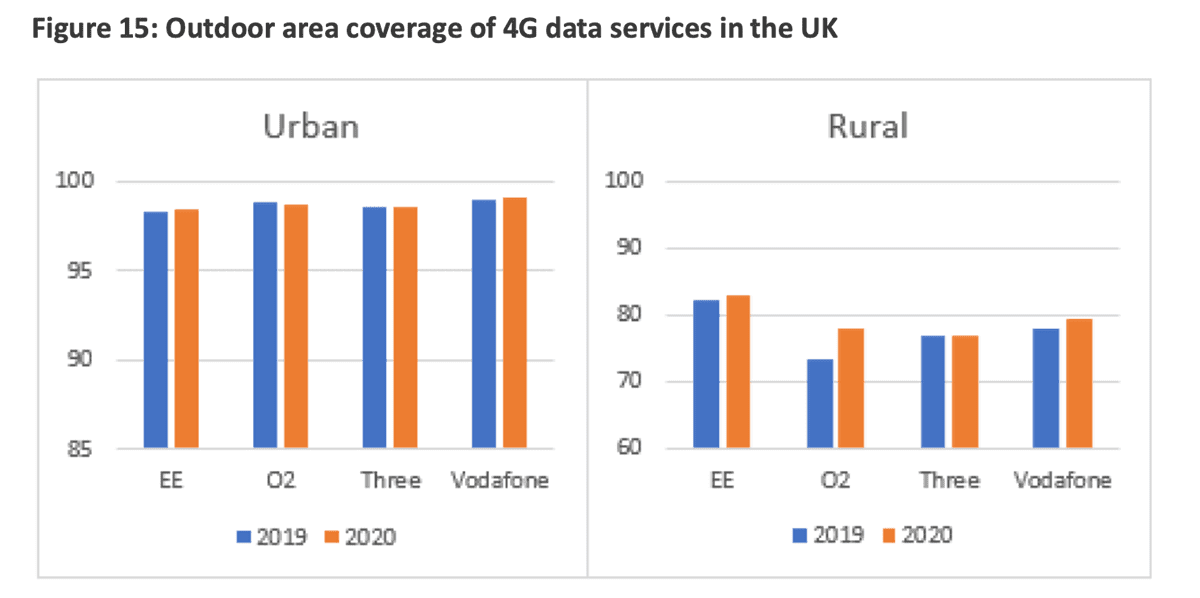
Ofcom say the increase in O2 rural network coverage may be more related to modelling than building new masts, although it's worth remembering that all networks are trying to improve their rural coverage anyway.
All have signed up the Shared Rural Network (SRN) agreement, and O2 have joined forces with Vodafone and Three to share over 200 new masts by 2024.
Their 2020 annual results released in February 2021 explained they had also boosted 4G services in 180,000 postcodes.
Meanwhile, EE are upgrading 4G services at over 500 sites by the end of 2021 to improve the reach of their 4G network.
Legal targets are in place for network operators to reach 88% of the UK by 2024 and then 90% by 2026, but EE is the closest to those results so far. Indeed, Opensignal's research published in April 2021 puts them ahead of their rivals for coverage and network availability.
Yet Ofcom's data shows the differences between the four nations when it comes to 4G geographic coverage:
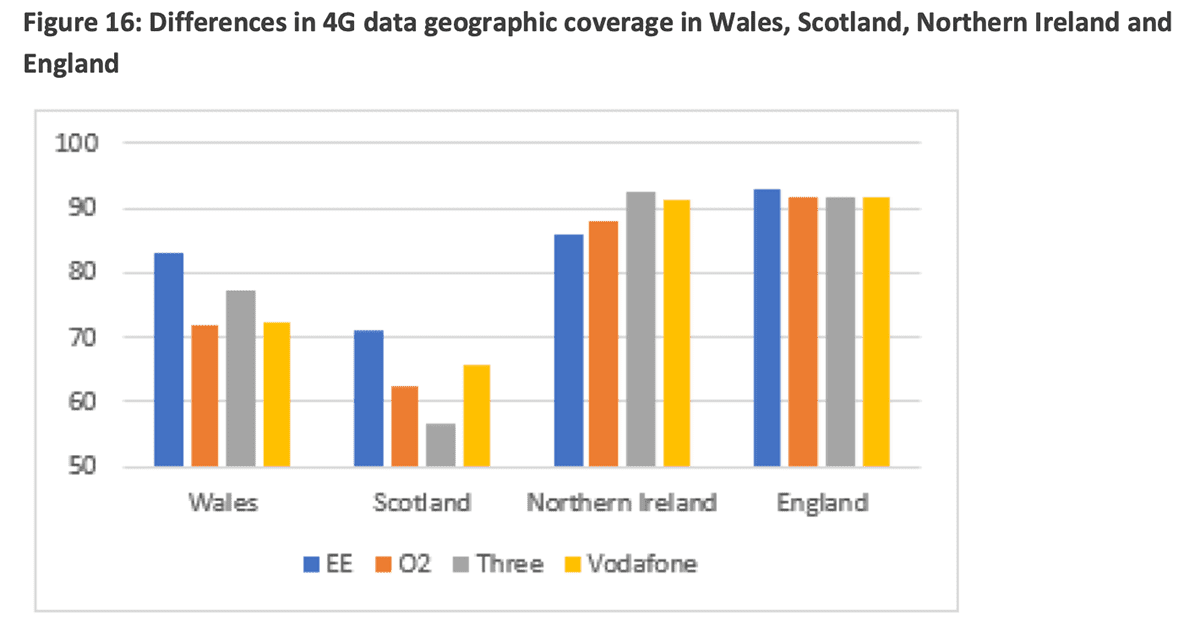
England and Northern Ireland have much better coverage overall, with O2 on a par with EE in England and ahead of them in Northern Ireland.
However, EE's coverage in Wales and Scotland is superior to O2's, mainly thanks to those differences in rural coverage we discussed above.
Finally, we have Ofcom data on indoor 4G coverage. This shows O2 slightly ahead compared to EE:
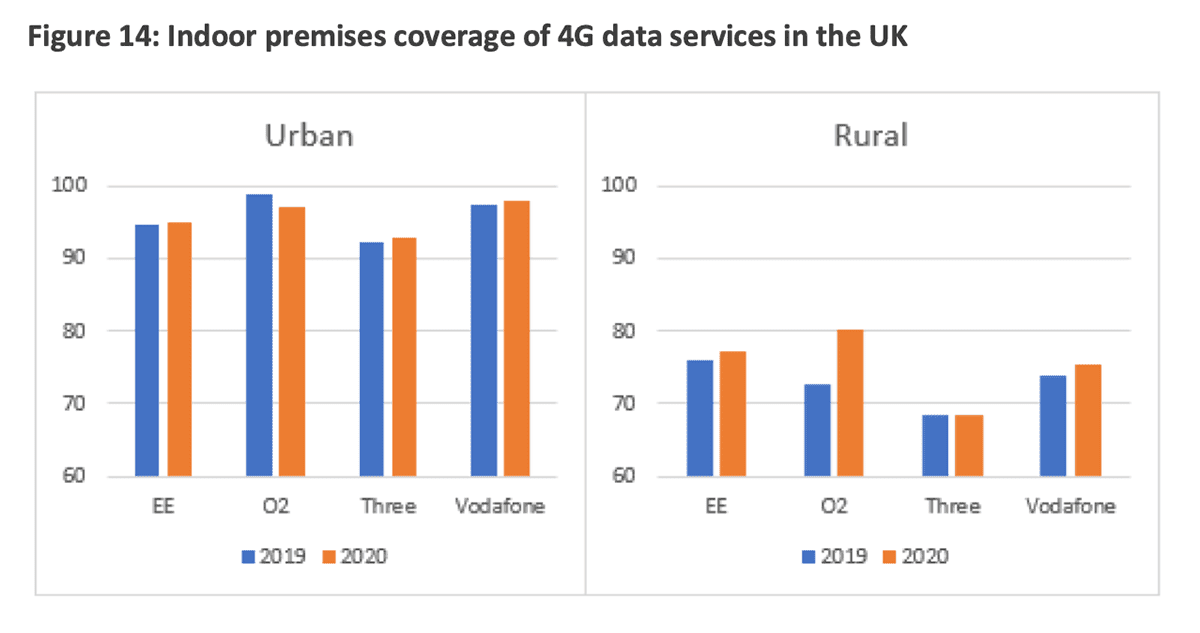
Mobile coverage is usually a local issue, and the fact that EE have wider geographical coverage may be pointless if they don't offer decent indoor coverage for a customer's home. That's why we'd always recommend running postcode checks on the websites of providers before signing up.
The good news is that 4G coverage from both O2 and EE will continue to increase in the years ahead. But what about 5G?
5G
Winner: EE's coverage within local areas is more extensive.
5G coverage from O2 and EE has been increasing rapidly since 2019.
The two networks have switched on services in broadly the same number of towns and cities (between 150 and 160 at the time of writing), but coverage within those areas is patchy.
We can go into a bit more depth on 5G coverage thanks to RootMetrics' bi-annual reports which look at 16 locations across the UK.
Their report for H2 2020 shows EE coverage within cities is much higher than O2's:
| O2 | EE | |
|---|---|---|
| Glasgow | Not enough data | 19.7% |
| Edinburgh | Not enough data | 19.6% |
| Belfast | 4.0% | 35.3% |
| Newcastle | 10.9% | 26.4% |
| Leeds and Bradford | 12.3% | 24.4% |
| Hull | 17.1% | 56.8% |
| Liverpool | 13.3% | 33.5% |
| Manchester | Not enough data | 38.0% |
| Sheffield | 10.4% | 41.9% |
| Nottingham | 11.8% | 57.0% |
| Leicester | 12.7% | 44.8% |
| Birmingham | 1.1% | 54.9% |
| Coventry | 9.0% | 24.8% |
| Cardiff | Not enough data | 38.7% |
| Bristol | Not enough data | 28.1% |
| London | 6.6% | 39.9% |
So, from these results it looks as if customers in EE's 5G locations are more likely to receive coverage than those in O2's 5G areas.
5G coverage is increasing all the time, so customers hoping to spend a lot of time using 5G on a 5G-capable device should check their local coverage on operators' websites.
Read more about 5G mobile broadband.
Speed
Winner: EE are the market leader on 4G and showing positive signs on 5G speeds too.
EE is the undisputed champion of 4G mobile speeds, with the most recent report from Opensignal covering the first months of 2021 showing their average speeds are double those offered by O2.
Their Download Speed Experience metric showed average EE speeds of 39.0Mbps compared to O2's 17.3Mbps.
This is backed up by data from RootMetrics looking at the average speeds of each mobile network (combining 4G and 5G results).
Their fastest median download speed was recorded in Hull with 82.8Mbps while their slowest was in Leeds with 37.7Mbps.
The results for O2 were markedly different. Their fastest was 32.0Mbps in Leicester with Bristol recording their lowest media download speed of 7.5Mbps.
To put it in stark terms: O2's best median download speeds in RootMetrics' test cities was still slower than EE's slowest.
On 5G, we can again refer to RootMetrics' 5G specific report for the second half of 2020, and we find that O2 are consistently fast on 5G services, beating EE's fastest median download speed by over 30Mbps (with 178.9Mbps in Belfast).
Yet RootMetrics noted EE were the only provider to post average speeds of 100Mbps in all test cities.
Overall, EE are in the lead on 4G speeds and showing excellent signs on 5G speeds too. With the two combined, it's difficult to look past them.
Extras
Winner: O2 include an Extra with most of their plans while EE's Smart Benefits require customers to sign up to a more expensive tariff.
O2 and EE have enhanced plan options which allow customers to add extra benefits to their mobile deals. O2 call these Extras while EE's are called Smart Benefits.
O2 Extras allow customers to add a service for free for up to 12 months. The options change regularly, but they are the exclusive partner of Disney+ in the UK so that's usually in the mix.
Yet the Extra doesn't last for the length of the contract as EE's Smart Benefits do (nor are Extras swappable as EE's version are). EE customers can also choose up to three swappable benefits on certain plans while O2 customers are limited to one.
The financial difference is that EE customers must sign up a specific Smart Plan whereas O2 customers receive an Extra as standard.
Adding extra subscriptions like this can be useful, but only if customers are likely to value the service and get the full use out of it.
For that reason, we prefer the O2 Extra system because customers aren't paying extra to access it, even though EE Smart Benefits are more comprehensive.
Customer service
Winner: EE have slightly lower overall complaint figures
Both O2 and EE could be said to have a good record on customer service, further buoyed by the fact that overall customer satisfaction for the mobile sector is at 90% (it's only 80% for broadband 77% for landline).
This is how O2 and EE stack up against each other in the most recent Ofcom Comparing Service Quality Report published in May 2021:
| O2 | EE | |
|---|---|---|
| Satisfaction with overall service | 91% | 92% |
| Satisfaction with value for money | 79% | 80% |
| Number of customers with a reason to complain | 7% | 9% |
| Overall satisfaction with complaint handling | 62% | 57% |
| Complaints completely resolved on first contact | 47% | 50% |
| Complaints per 100,000 customers in 2020 | 8 | 6 |
| Average call waiting time | 2 minutes 17 seconds | 2 minutes 9 seconds |
As we can see, both providers have customer service strengths, with O2 having fewer customers with a reason to complain and more satisfied customers when it comes to handling those complaints.
Yet EE have a marginal lead on two of the most important metrics (overall satisfaction and satisfaction with value for money), plus they have slightly lower complaint levels.
It's enough to help them edge ahead of O2, but they're both solid performers on customer service, so either would be a good choice on this basis.
One final point: O2 were fined £10.5m by Ofcom in February 2021 for overcharging 250,000 customers on their final bills over an eight-year period.
Learn more about mobile customer service in our dedicated guide covering large and small providers.
Verdict: who wins?
Overall winner: EE are faster, have wider coverage and a strong customer service record to back it all up.
O2 and EE both have strengths as mobile operators, and the choice for customers may come down to which provider has better coverage in the areas where they spend a lot of time - and whether they have switched on 5G services there yet.
However, EE have a few key things going for them:
- 4G speeds are much faster than O2's
- Best 4G geographical coverage of all operators
- Handset tariffs can be cheaper
- Excellent customer service record
It's true customers looking for cheaper (and more flexible) SIM only deals may favour O2, along with those happy to sign up to a 36-month contract for lower monthly fees.
But EE's sheer speed wins out for now, and they're our pick out of these two.



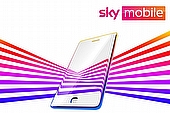



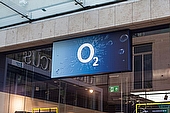

Comments